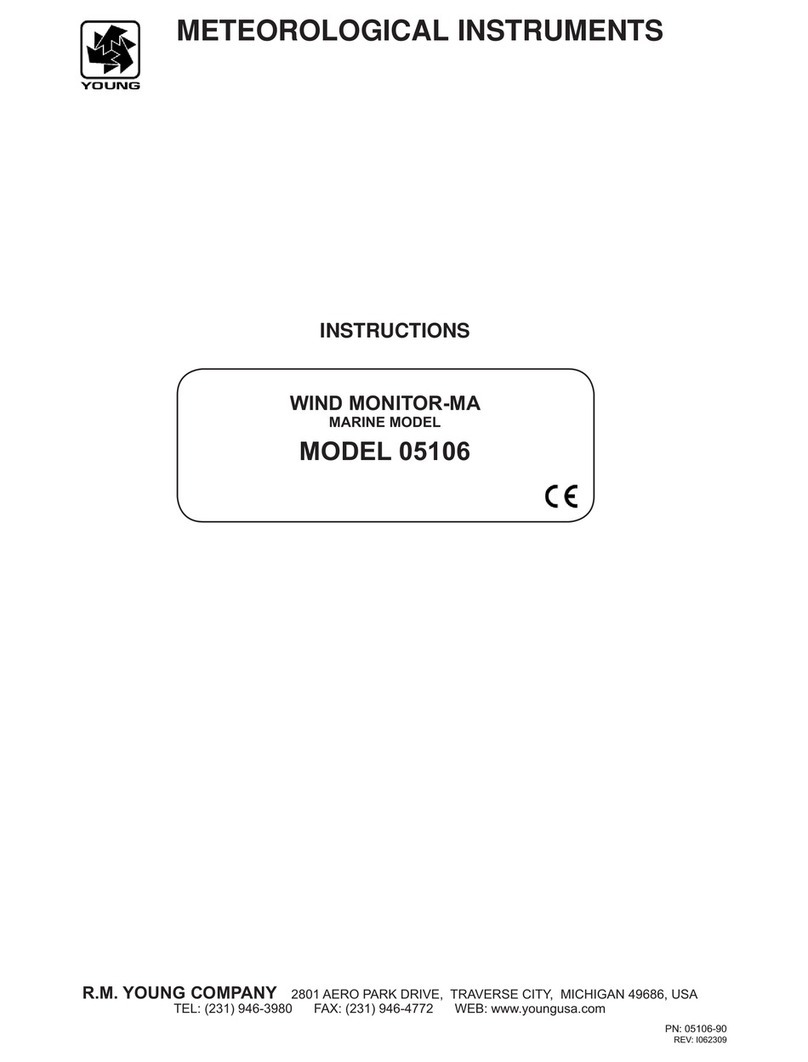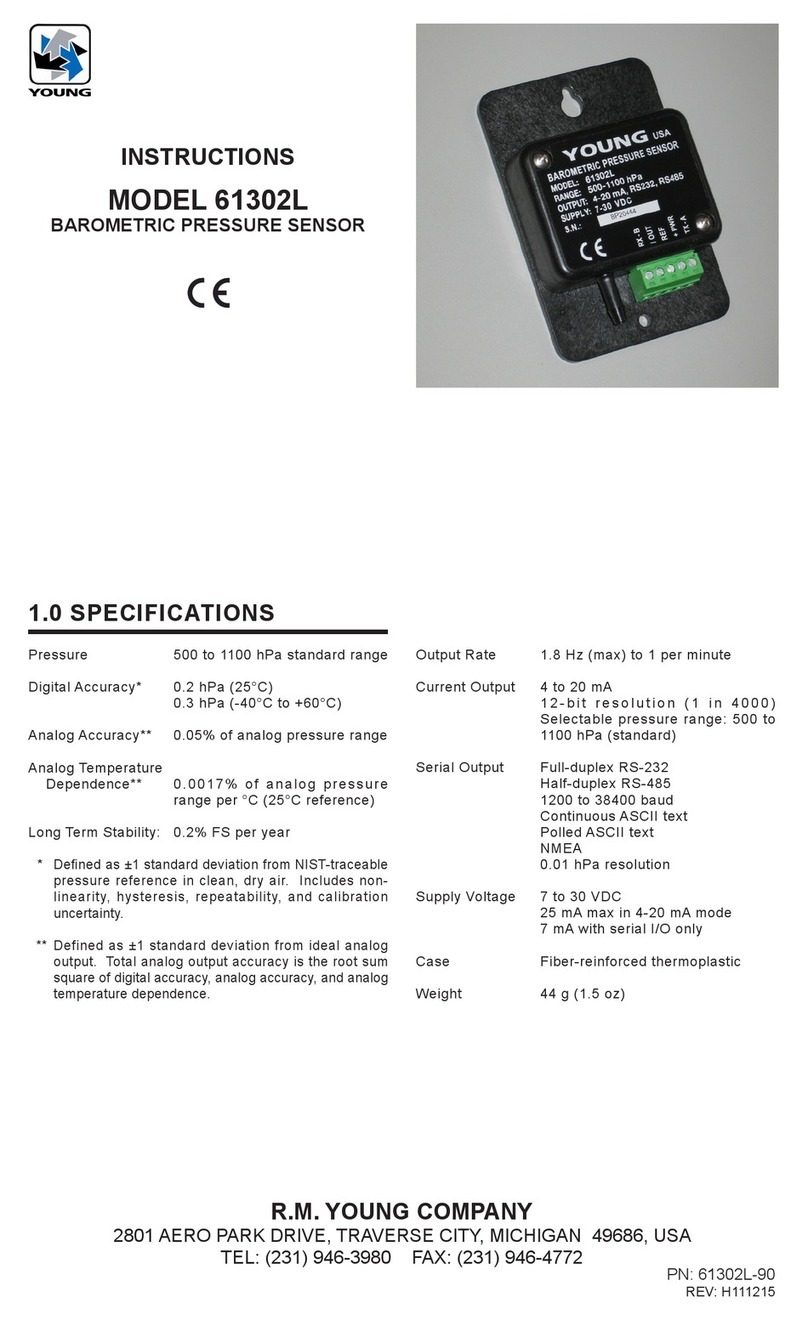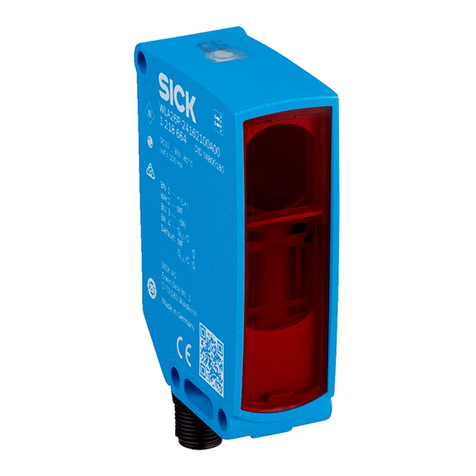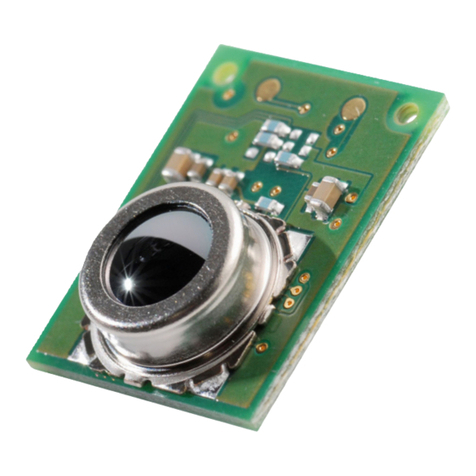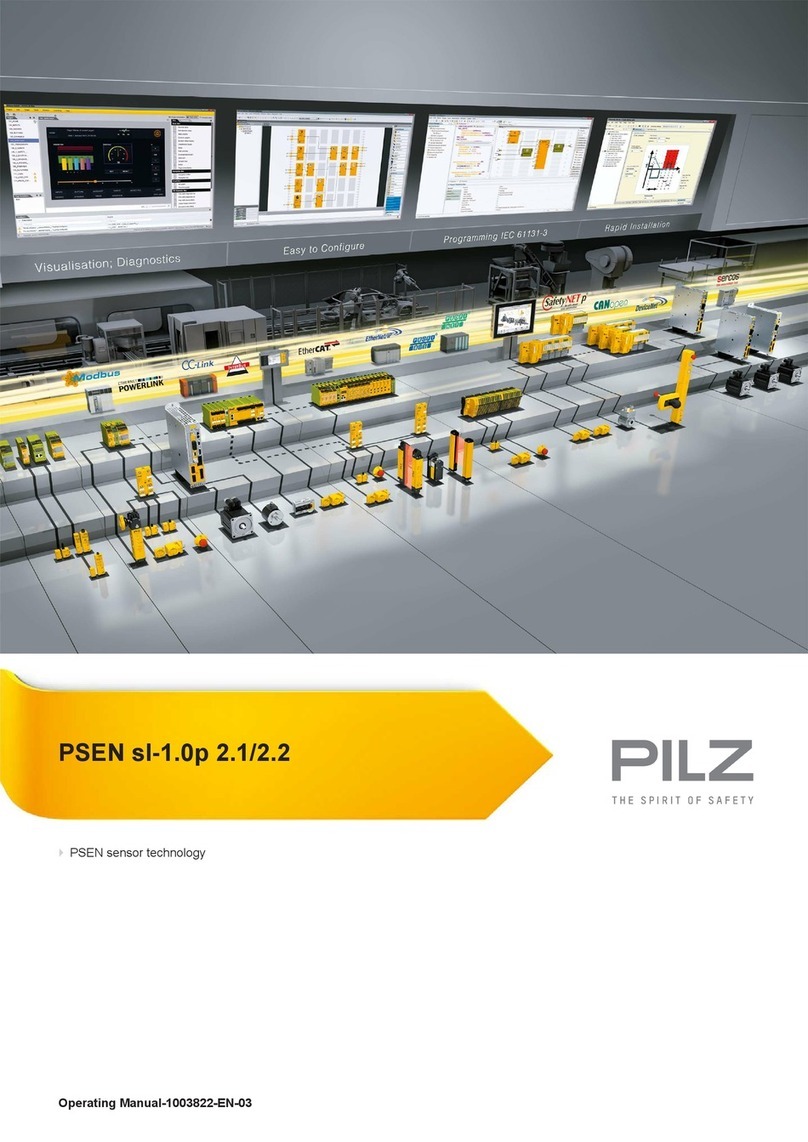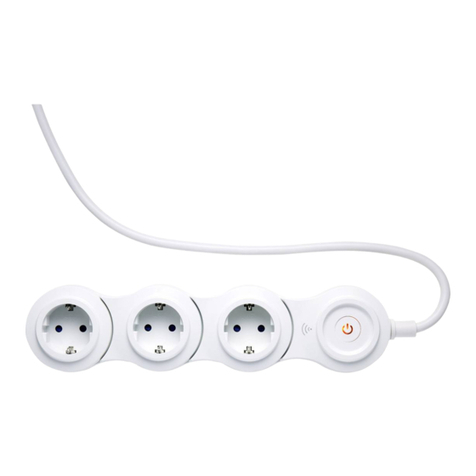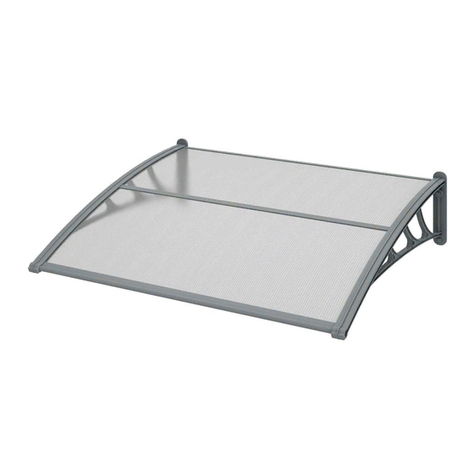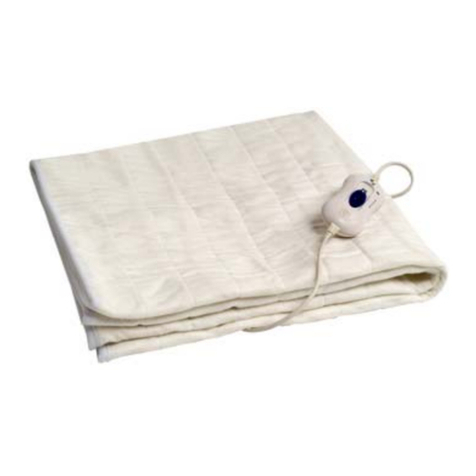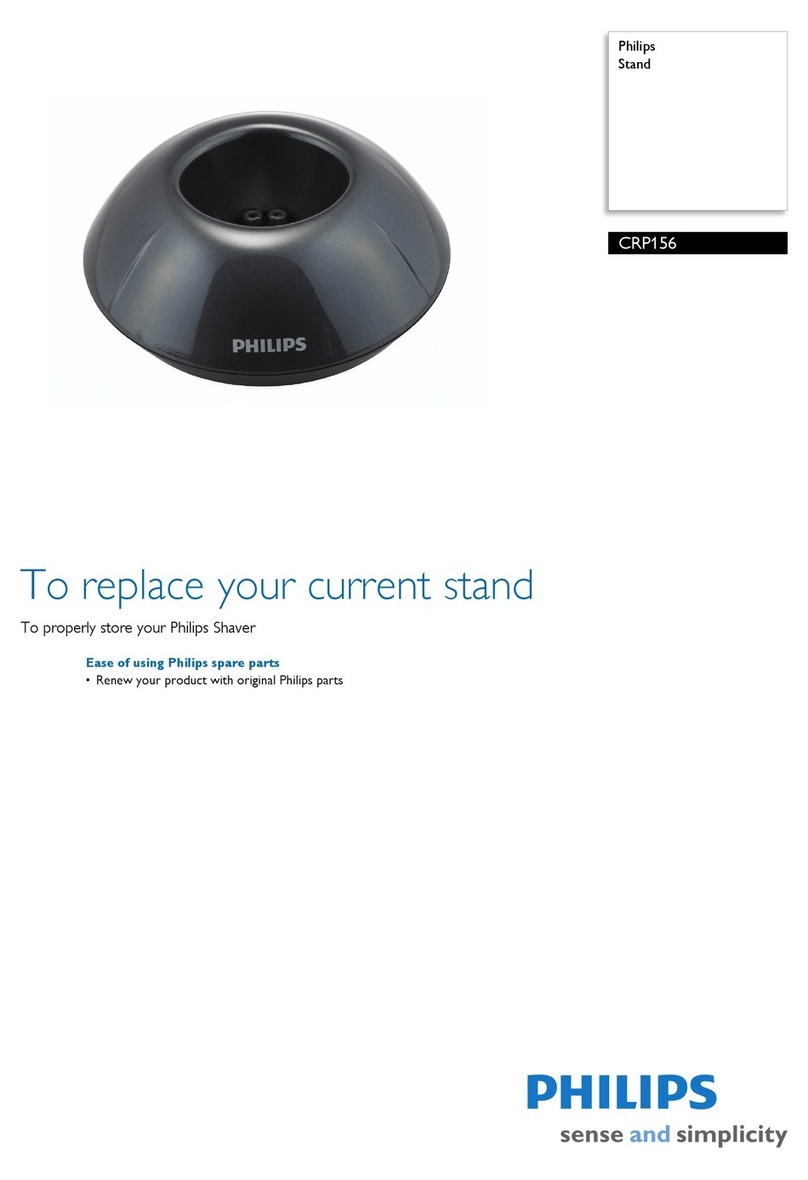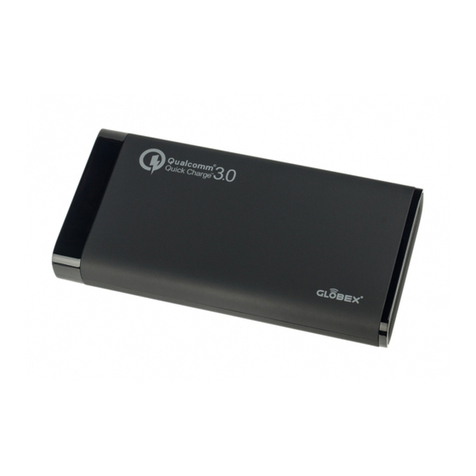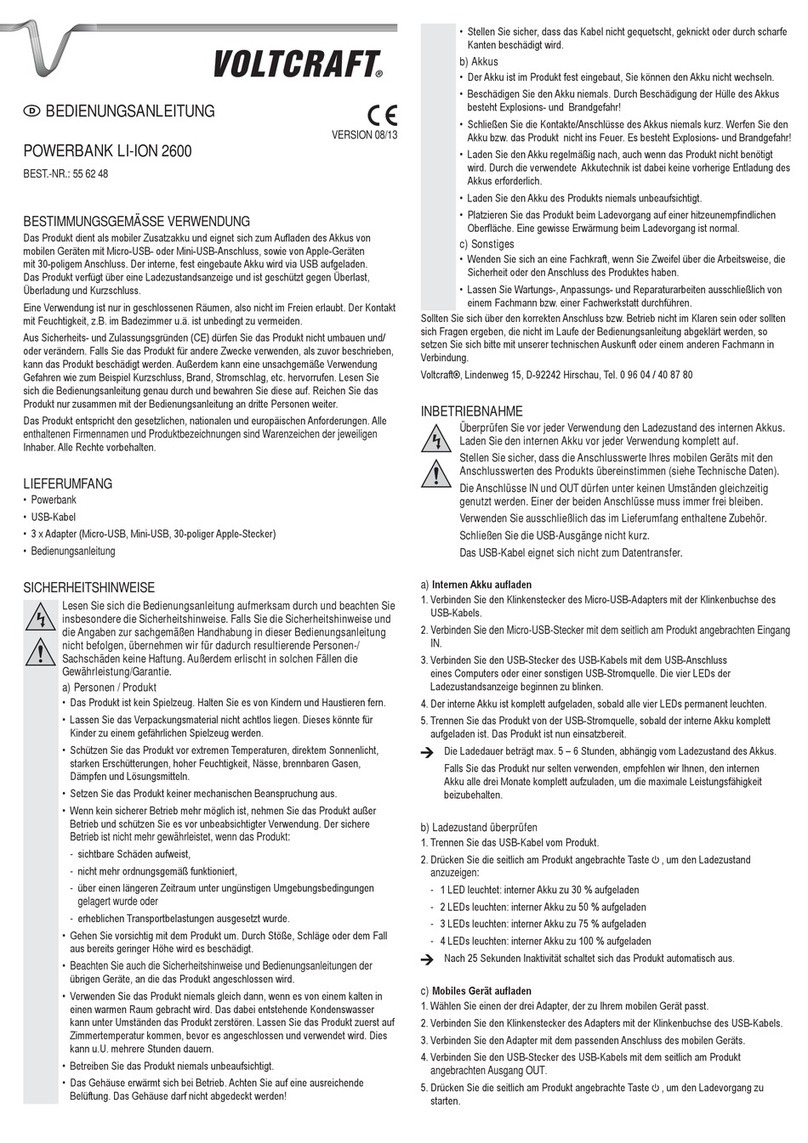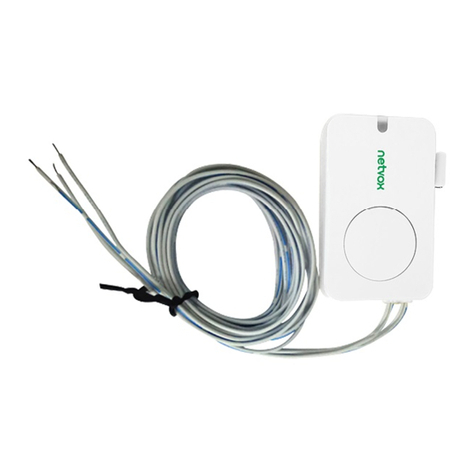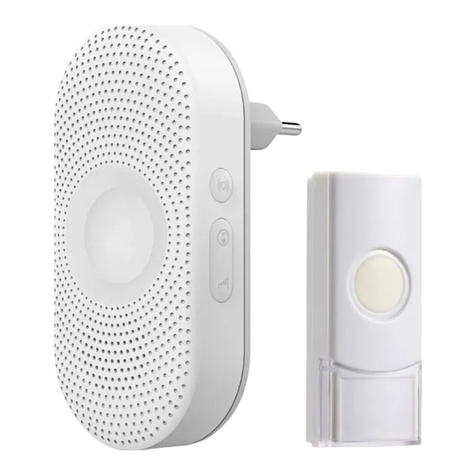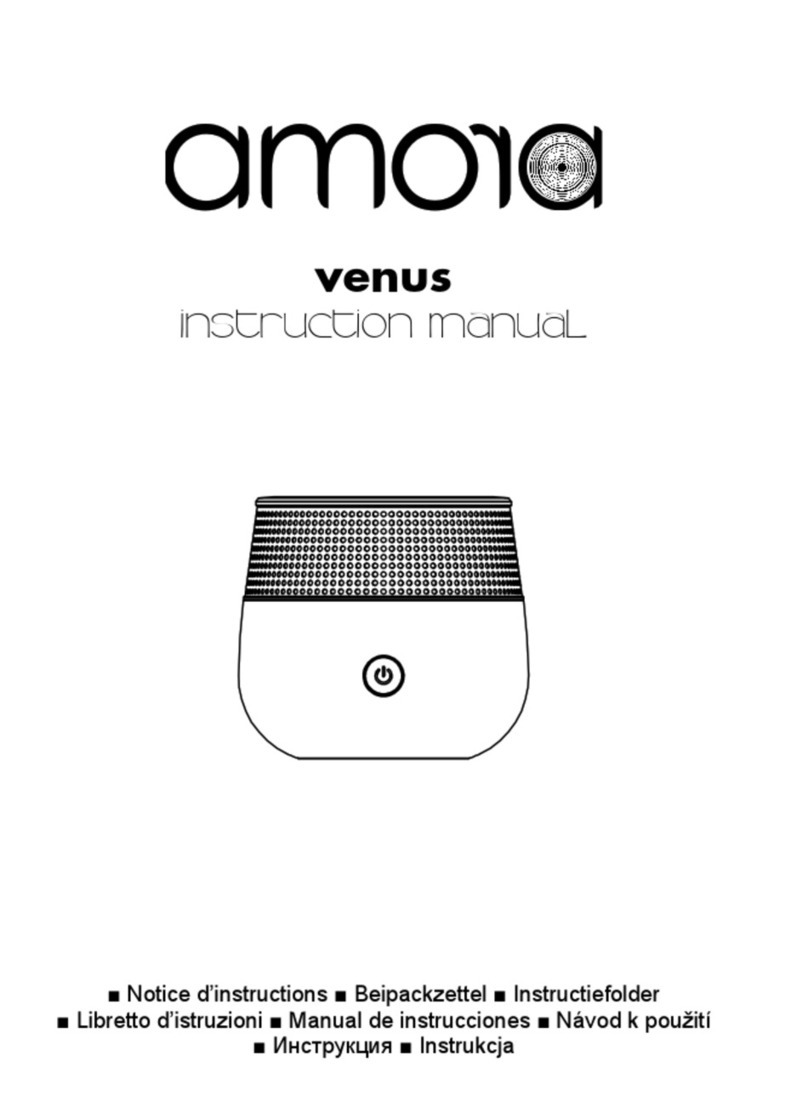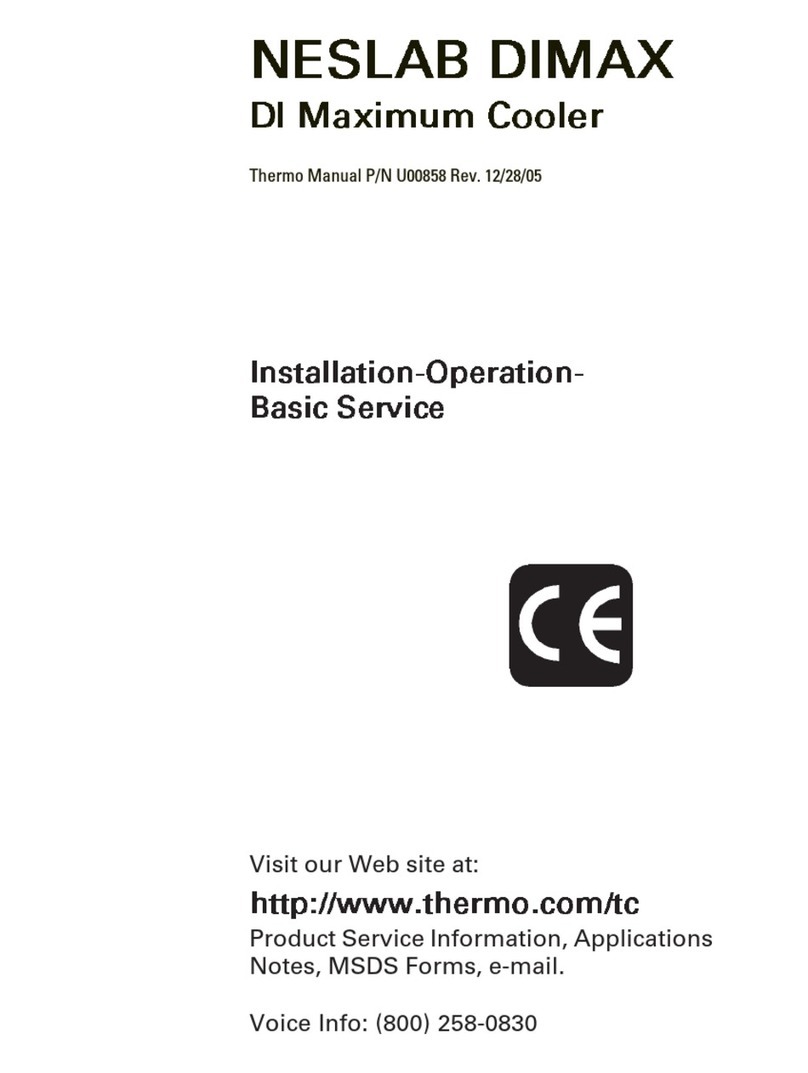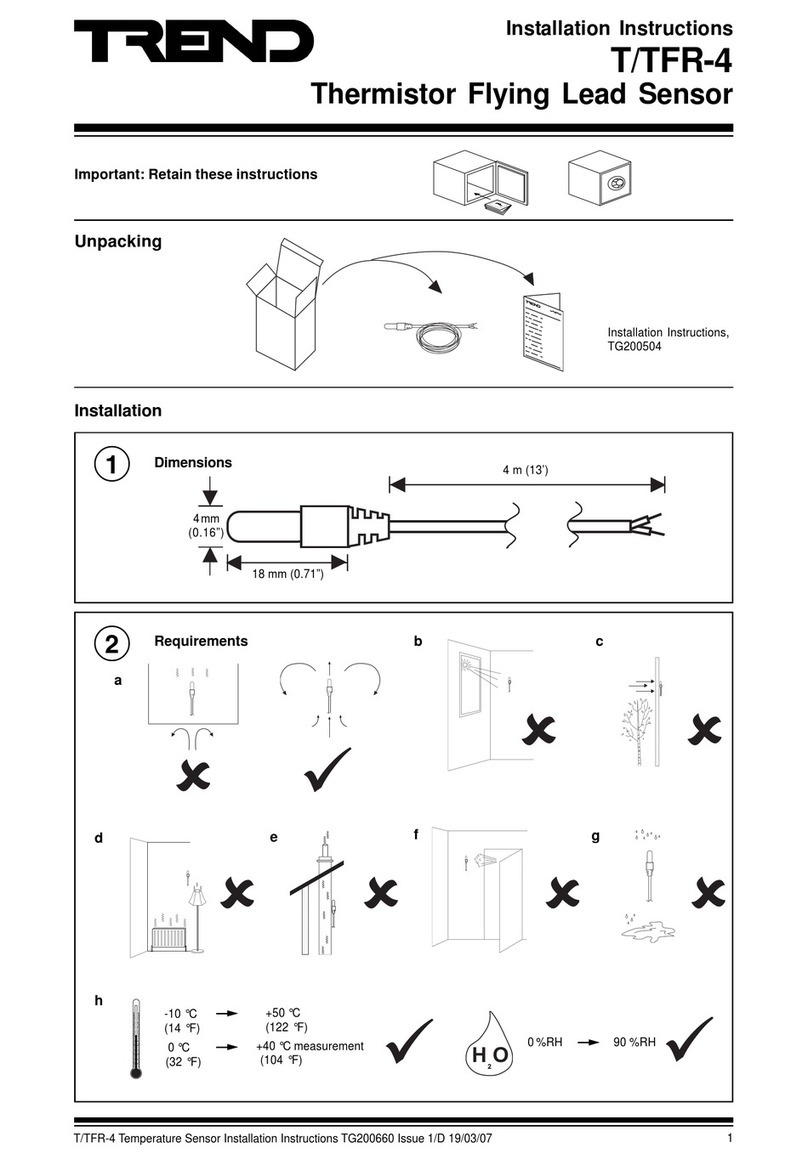R.M. Young 61302V User manual

MODEL 61302V
BAROMETRIC PRESSURE SENSOR
INSTRUCTIONS
R.M. YOUNG COMPANY
2801 AERO PARK DRIVE, TRAVERSE CITY, MICHIGAN 49686, USA
TEL: (231) 946-3980 FAX: (231) 946-4772
PN: 61302V-90
REV: I111215
1.0 SPECIFICATIONS
Pressure 500 to 1100 hPa standard range
Digital Accuracy* 0.2 hPa (25°C)
0.3 hPa (-40°C to +60°C)
Analog Accuracy** 0.05% of analog pressure range
Analog Temperature
Dependence** 0.0017% of analo g pressure
range per °C (25°C reference)
Long Term Stability: 0.2% FS per year
*
Dened as ±1 standard deviation from NIST-traceable
pressure reference in clean, dry air. Includes non-
linearity, hysteresis, repeatability, and calibration
uncertainty.
**Defined as ±1 standard deviation from ideal analog
output. Total analog output accuracy is the root sum
square of digital accuracy, analog accuracy, and
analog temperature dependence.
Output Rate 1.8 Hz (max) to 1 per minute
Voltage Output 0 to 5000 mV (standard)
0 to 2500 mV
12-bit resolution (1 in 4000)
Selectable pressure range:
500 to 1100 hPa (standard)
Serial Output Full duplex RS-232
1200 to 38400 baud
Continuous ASCII text
Polled ASCII text
NMEA
0.01 hPa resolution
Supply Voltage 7 to 30 VDC
2.8 mA with Vout (standard)
1.4 uA shutdown (Trig=0V)
7 mA with serial I/O
Case Fiber-reinforced thermoplastic
Weight 44 g (1.5 oz)

Better effective resolution may be achieved by mapping
the voltage output to a narrower range of pressure with
the VOUT HI and VOUT LO parameters. For example, with
VOUT LO set to 950 hPa and VOUT HI set to 1050 hPa and
the VOUT Scale set to 0-5000 mV:
hPa = 0.02 * mV + 950
Effective resolution is about 0.025 hPa
Please see section 4.3 below for details on changing the
VOUT HI and LO parameters.
With jumper P4 configured for voltage output, a special
TRIG input may be used to control barometer power. When
TRIG=0V, all processes cease and power consumption is
reduced to 1.4uA. When the voltage on TRIG > 1.8V (or left
floating), normal operation resumes with a powerup reset.
The TRIG input connection is optional. It may be connected
to +PWR or left floating.
4.2 SERIAL OUTPUT
Jumper settings and software parameters determine
RS-232 serial communication format. The Appendix A Wiring
Diagram shows jumper locations and function.
P1 A/B/C sets output format, baud rate, output rate, and
averaging.The table below summarizes P1 configurations.
P3 A/B sets RS-232 hardware function. AUTO (A) enables
RS-232 hardware when valid standard RS-232 signals
are present at RX and TX. When not present, the RS-232
hardware is disabled to save power. FIXED (B) enables RS-
232 hardware at all times so it can be used with some non-
standard RS-232 signals.
P4 A/B configures the terminal connections for RS-232.
Both jumpers must be in position A for RS-232 serial
communication.
Format Description
Continuous ASCII
Text
(standard)
9600 baud
10 sample average
1.8 Hz output
Polled ASCII Text 9600 baud
10 sample average
Output when polled
Marine NMEA 4800 baud
10 sample average
1Hz output
Software Output parameters determined by
software settings
Note that NMEA output is normally specified to work on RS-
422 and RS-485 networks. The NMEA output here conforms
to the standard data format but the electrical connection
uses RS-232 signal levels.
In POLLED ASCII mode, the unit sends data only after
receiving a poll command. The poll command is Ma! where
‘a’ is the address value. The standard address is ‘0’ (ASCII
48) for a poll command of M0! Please see section 4.3 for
details on changing the poll address.
Standard baud rate is 9600 but any of several available
baud rates between 1200 and 38400 may be used.
2.0 INTRODUCTION
MODEL 61302V Barometric Pressure Sensor is a versatile
electronic barometer featuring high accuracy, low power,
wide operating temperature range, and calibrated voltage
output or RS-232 serial data I/O.
Low power consumption and wide temperature range make
the 61302V ideal for remote applications using battery or
solar power.
Full scale voltage output may be set to span any portion
of the 500 to 1100 hPa operating range. RS-232 serial
I/O options include continuous or polled ASCII text output
or NMEA marine output. The sensor is supplied with the
following standard configuration:
Voltage output
0 to 5000 mV = 500 to 1100 hPa
10 samples averaged
1.8 Hz update rate
3.0 INSTALLATION
The sensor operates over a temperature range of -40°C to
+60°C and must remain dry.
Electrical connections are made with the 5-position terminal
plug included with the sensor. Jumper settings may be used
to select operating options. Access jumpers by loosening
two screws in the sensor enclosure and removing the cover.
See Appendix A for wiring details and jumper settings.
If changed from the standard configuration, please note that
the software Vout Scale parameter must be set to agree with
the hardware Voltage Output Scale jumper (P3) in order to
achieve calibrated output.
4.0 OPERATION
Operation begins approximately 1 second after power is
applied. Output will appear after a delay determined by
the number of samples averaged and the output rate. With
default values (1.8 Hz output and 10 samples averaged),
outputs will begin after an initial 5 second delay then remain
continuous at the 1.8 Hz rate. Parameters for output rate
and number of samples averaged may be changed using
software commands.
4.1 VOLTAGE OUTPUT
Hardware jumpers and software parameters determine
voltage output operation. Appendix A shows jumper
configurations.
Both P4 jumpers must be in position B for voltage output.
Jumper P 3 sets the Voltage Output Scale to either
0-5000 mV or 0-2500 mV. Please note that jumper P3 must
agree with the software Vout Scale parameter in order to
achieve calibrated output.
The voltage output scale may be mapped to any part of the
500 to 1100 hPa pressure range using the VOUT HI and
VOUT LO software parameters. The standard setting maps
0 to 5000 mV with 500 to 1100 hPa. With this setting:
hPa = 0.12 * mV + 500
Effective resolution is about 0.15 hPa

4.3 SOFTWARE COMMANDS
Software commands sent via serial communication may be
used to set operational parameters. The sensor must be
configured for serial communication and connected to a PC
or other compatible device using a program like HyperTerm.
New settings are stored in temporary memory and
must be burned to flash with command CMD420 to be
retained.
Note that the P 1 jumper must be configured for
SOFTWARE format to alter baud rate, sample average
count, and output rate parameters.
Although the sensor may receive commands at any
time, measurement output may be paused by sending
three ESC (ASCII 27) characters or CMD300 1. While
paused, COMMAND mode is indicated by a “>” prompt.
All commands must be terminated with a carriage return
CR (ASCII 13).
Use “?” to list available commands as shown below.
>?
YOUNG 61300 SERIES BAROMETER V2.03
----------------------------------------
CMD100 n OUTPUT PERIOD (0-60 sec)
CMD105 n AVG SAMPLE COUNT (0-32)
CMD110 n OUTPUT FORMAT
(1=ASCII 2=POLLED 3=NMEA 4=RAW 5=DIAG)
CMD120 n MULTIPLIER (10000 = 1.0000)
CMD125 n OFFSET (hPA x 100)
CMD130 n SEA LEVEL CORRECTION (hPA x 100)
CMD140 n VOUT RANGE HI (500-1100)
CMD142 n VOUT RANGE LO (500-1100)
CMD144 n VOUT SCALE (2=2.5V 5=5V)
CMD150 c POLL ADDR CHAR
CMD160 n BAUD RATE (38400,9600,4800,2400,1200)
CMD300 n 1=STOP, 2=RUN
CMD310 n FORCE VOUT (0-5000 FULL SCALE)
CMD400 n 1=RPT TEXT, 2=RPT CODE ONLY
CMD410 GET CAL TABLE
CMD420 STORE SETUP PARAMETERS
>
CMD100 n sets output period in seconds. When set to zero,
the output rate is about 1.8 per second.
CMD105 n sets the average sample count. Higher sample
count yields more stable readings but will lengthen
the startup delay.
CMD110 n sets output format. RAW and DIAG settings are
for factory use only.
CMD120 n sets the output multiplier. 10000 represents
1.0000
CMD125 n sets the output offset in hPa x 100
CMD130 n sets the sea level correction in hPa x 100
=[Punadjust *( Mult / 10000)] + [(Offset /100) + (Correction Sea Lvl / 100)]
CMD140 n sets the Vout Pressure Range HI
CMD142 n sets the Vout Pressure Range LO
Vout Pressure Range HI must be greater than Vout
Pressure Range LO
CMD144 n sets the Vout Scale. 2 = 0 to 2500 mV. 5 = 0
to 5000 mV. This parameter setting must agree with
the physical P3 jumper position to achieve calibrated
voltage output.
CMD150 c sets the poll address character. Any ASCII
character from ‘0’ (ASCII 48) to ‘z’ (ASCII 122) may
be used.
CMD160 n sets the baud rate. Acceptable values are
38400, 9600, 4800, 2400, and 1200. Note that the
baud rate change occurs immediately after the
command is received. Therefore, in order to continue
communicating, the serial communication program
that issued the command must also change to match.
CMD300 n causes the sensor to pause or resume
measurement. 1 = Stop, 2 = Run.
CMD400 n causes the sensor to issue a report
summarizing parameter settings.
1 = RPT text
2 = RPT code only
CMD410 retrieves the internal calibration table. This is for
factory use only.
CMD420 burns new parameter settings to flash memory.
This step must take place to retain changes otherwise
parameters will revert to the previous values at the
next powerup.
5.0 MAINTENANCE
The MODEL 61302V barometer requires no regular
maintenance. Periodic calibration certification, if required,
is available from the factory.
6.0 WARRANTY
This product is warranted to be free of defects in materials
and construction for a period of 12 months from date of
initial purchase. Liability is limited to repair or replacement
of defective item. A copy of the warranty policy may be
obtained from R. M. Young Company.
7.0 EMC COMPLIANCE
This device complies with Part 15 of the FCC Rules. Operation
is subject to the following two conditions: (1) this device may
not cause harmful interference, and (2) this device must accept
any interference received, including interference that may cause
undesired operation.
This equipment has been tested and found to comply with the
limits for a Class A digital device, pursuant to part 15 of the
FCC Rules. These limits are designed to provide reasonable
protection against harmful interference when the equipment
is operated in a commercial environment. This equipment
generates, uses, and can radiate radio frequency energy and, if
not installed and used in accordance with the instruction manual,
may cause harmful interference to radio communications.
Operation of this equipment in a residential area is likely to
cause harmful interference in which case the user will be
required to correct the interference at his own expense.
This ISM device complies with Canadian /CES-001.
Cet apparei/ISM est conforme a Ia norme NMB-001 du Canada.
EN55011/CISPR 11, Group 1, Class B device
Class B equipment is suitable for use in domestic establishments
and in establishments directly connected to a low voltage power
supply network which supplies buildings used for domestic
purposes.
8.0 CE COMPLIANCE
This product has been tested and complies with European
CE requirements for the EMC Directive. Please note that
shielded cable must be used.

APPENDIX A
61302V BAROMETER
TYPICAL WIRING CONNECTIONS
Table of contents
Other R.M. Young Accessories manuals
